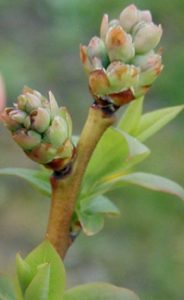Winter moth update April 16th
Winter moth update, April 16, 2022
Winter moth eggs finished hatching this past week. Now, and for the next week or two, is a good time to check your apple and blueberry buds for winter moth caterpillars. Caterpillar frass (insect poop) is much easier to find than actual caterpillars. I’ve seen one small apple orchard and one blueberry farm in Washington County that should spray for winter moths within the next couple of weeks. And my two blueberry bushes in Charlestown have many winter moth caterpillars. You need to pry open buds to find frass or caterpillars. Apple buds are easier to check for caterpillars. It’s very helpful to use a magnifying glass to see caterpillars or frass.
Fig 1. Winter moth caterpillar found inside a blueberry bud once the bud was pried open. Caterpillar frass is also visible and often easier to find than a caterpillar.
We don’t have a good threshold to indicate the need to spray apples, pears, or blueberries for winter moths. Some Nova Scotian guides recommend spraying apple trees when 1-2 caterpillars are found in 20 buds (>5% infested buds).
A good time to spray for winter moths is from tight cluster to bud separation–when the flower buds start separating from the cluster, but before blossoms open. So right now is a good time to check buds. If you find more than 5% of buds with caterpillars or frass you may want to apply an insecticide.
All common insecticides labeled for apples and blueberries control winter moth caterpillars well. Bt insecticides (such as Dipel) are also effective. Bt insecticides kill only caterpillars, so don’t harm bees and other insects.
Fig 2 & 3. Tight cluster bud stage of apples and blueberries is the time to look for winter moth caterpillars. Blueberry buds are more difficult to check than apple buds.
 Home
Home Browse
Browse Close
Close Events
Events Maps
Maps Email
Email Brightspace
Brightspace eCampus
eCampus





